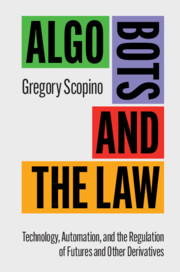Book contents
- Reviews
- Algo Bots and the Law
- Algo Bots and the Law
- Copyright page
- Contents
- Preface
- Introduction
- 1 Key Concepts: Algorithms, Artificial Intelligence, and More
- 2 Economic Definitions of Common Derivatives
- 3 Legal and Regulatory Definitions of Derivatives and Other Financial Instruments
- 4 FinTech: From Science Fiction to Non-Fiction
- 5 The Regulatory Framework for the US Derivatives Markets
- 6 Gateways to the Futures Markets – FCMs
- 7 Collective Investment Vehicles and Investment Advisors
- 8 Salespeople, Supervisors, Owners, and Enumerated Others
- 9 Trading Floor Denizens
- 10 Regulating Digital Intermediaries
- 11 States of Mind: From Zero to Specific Intent
- 12 Market Manipulation: Then and Now
- 13 Fraud Is Many Things (for Humans and Robots)
- 14 Disruptive Trading Practices
- 15 Spoofing: Market Disruption Made Easy by Technology
- 16 Adequately Supervising the Overseers of Algo Bots
- 17 Flash Events
- 18 Algo Bots All over the World
- 19 Conclusion
- Index
2 - Economic Definitions of Common Derivatives
Published online by Cambridge University Press: 02 October 2020
- Reviews
- Algo Bots and the Law
- Algo Bots and the Law
- Copyright page
- Contents
- Preface
- Introduction
- 1 Key Concepts: Algorithms, Artificial Intelligence, and More
- 2 Economic Definitions of Common Derivatives
- 3 Legal and Regulatory Definitions of Derivatives and Other Financial Instruments
- 4 FinTech: From Science Fiction to Non-Fiction
- 5 The Regulatory Framework for the US Derivatives Markets
- 6 Gateways to the Futures Markets – FCMs
- 7 Collective Investment Vehicles and Investment Advisors
- 8 Salespeople, Supervisors, Owners, and Enumerated Others
- 9 Trading Floor Denizens
- 10 Regulating Digital Intermediaries
- 11 States of Mind: From Zero to Specific Intent
- 12 Market Manipulation: Then and Now
- 13 Fraud Is Many Things (for Humans and Robots)
- 14 Disruptive Trading Practices
- 15 Spoofing: Market Disruption Made Easy by Technology
- 16 Adequately Supervising the Overseers of Algo Bots
- 17 Flash Events
- 18 Algo Bots All over the World
- 19 Conclusion
- Index
Summary
Before analyzing how technological innovation has changed the financial markets, one must obtain a basic understanding of some terms and concepts that are necessary to understand these markets in the first instance. As mentioned in the Introduction, the United States has two market regulators: the Commodity Futures Trading Commission (CFTC) and the Securities and Exchange Commission (SEC). In deciding to have two market regulators, Congress established a framework in which the SEC oversees the markets for securities, which include stocks in companies, as well as bonds, government securities, and even stock options and other types of derivatives that are considered to be securities under US law. The CFTC, on the other hand, governs the markets for futures contracts, commodity options, swaps, and other derivatives that the law does not categorize as securities. Some have criticized the fact that the United States has two market regulators, as opposed to one consolidated regulator for both securities and futures markets.
- Type
- Chapter
- Information
- Algo Bots and the LawTechnology, Automation, and the Regulation of Futures and Other Derivatives, pp. 48 - 79Publisher: Cambridge University PressPrint publication year: 2020



